Bottle gourd
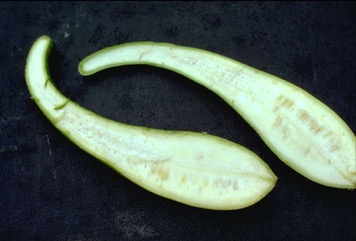
A tropical plant. It grows from sea level up to 2700 m altitude in the tropics. It grows best in a warm humid climate. It is sensitive to frost. It prefers full sunlight. In Nepal it grows to about 2200 m altitude. It grows best with a night temperature of 17-23°C and day temperatures of 28-36°C. It can grow in arid places. In Argentina it grows below 500 m above sea level. It suits hardiness zones 10-12.
Also known as:
Agusi, Alabu, Amabhanga, Arivolahy, Bagwa, Bak, aru'u, Bau, Bhopala, Bogalau, Bonglang, Bu, Bu-thabeik, Cabaca, Calabash gourd, Calabaza, Cheho, Core, Crockneck gourd, Di, Didi, Digo, Diya labu, Doodhi, Dudhi, Dudhiva, Dudhya, Egusi, Ekiryo, Eparra, Fahandu, File, Footi, Ghia, Ghiba, Ghiya, Guicharo, Guiro, Halagumbala, Holim, Hu lu gua, Ikhomane, Inshubaba, Iselwa, Kaddu, Kaka, Kakaigba, Kalabas, Ka tuk, Kalubay, Khil, Kikuu, Kiwa, Klook, Kwa-kwa, Labu air, Labu botel, Lakeru lilin, Lami-core, Lau, Laua, Lauka, Lauki, Laushak, Leraja, Limb, Louki, maPudzi, Maraga, Marimbo, Mbika nkalu, Milau, Mingi, Mirandjo-lo, Moraka, Mutaarmu, Naam tao, Namtao, Ntshubaba, Omparsa, Opo, Opu, Orde, Pe hipap, Pucuo, Sego, Senem, Shorakkai, Shubaba, Sorekayi, Sorrakaya, Suku, Surakkai, Surupha, Tambungaw, Tearau, Teneyu, Trumpet Gourd, Tshukumbu, Tumada, Tumri, Um, Undugue, Ungau, Ungu, Upo, Uum, Vago, Weezhd kadee, White-flower gourd, Yomb, Yungu, Yuugao
Synonyms
- Cucumis bicirrha J. R. Forst. ex Guill.
- Cucumis lagenaria (L.) Dumort.
- Cucumis mairei H. Lev.
- Cucurbita idolatrica Willd.
- Cucurbita lagenaria L.
- Cucurbita leucantha Duch.
- Cucurbita pyriformis M. Roem.
- Cucurbita siceraria Molina
- Cucurbita vittata Blume
- Adenopus abyssinicus Hook. f. var. somaliensis Chiov.
- Lagenaria bicornuta Chakrav.
- Lagenaria idolatrica (Willd.) Ser. ex Cogn.
- Lagenaria leucantha (Duch.) Rusby
- Lagenaria vulgaris Seringe
Edible Portion
- Seeds, Leaves, Fruit, Vegetable, Flowers
Where does Bottle gourd grow?
Found in: Africa, Angola, Asia, Australia, Bangladesh, Benin, Bhutan, Botswana, Brazil, Burkina Faso, Burundi, Cambodia, Cameroon, Central Africa, Central African Republic, CAR, Central America, Chad, Chile, China, Congo DR, Costa Rica, Côte d'Ivoire, Cuba, Dominican Republic, East Africa, Easter Island, East Timor, Egypt, Eritrea, Eswatini, Ethiopia, Fiji, FSM, Gabon, Gambia, Ghana, Guam, Guatemala, Guiana, Guianas, Guinea, Guinée, Guinea-Bissau, Guyana, Haiti, Hawaii, Himalayas, India, Indochina, Indonesia, Ivory Coast, Japan, Kenya, Korea, Laos, Liberia, Madagascar, Malawi, Malaysia, Mali, Marquesas, Mauritania, Mauritius, Mexico, Mozambique, Myanmar, Namibia, Nepal, New Zealand, Niger, Nigeria, North Africa, North America, Northeastern India, Pacific, Pakistan, Papua New Guinea, PNG, Paraguay, Peru, Philippines, Pohnpei, Puerto Rico, Rwanda, Sao Tome and Principe, SE Asia, Senegal, Serbia, Seychelles, Sierra Leone, Sikkim, Singapore, Solomon Islands, Somalia, South Africa, Southern Africa, South America, Sri Lanka, Sudan, Suriname, Swaziland, Taiwan, Tajikistan, Tanzania, Thailand, Timor-Leste, Togo, Tuvalu, Uganda, Uruguay, United States, Vanuatu, Venezuela, Vietnam, West Africa, West Indies, Zambia, Zimbabwe
Notes: There are 6 Lagenaria species. They are tropical vines.
Status: It is a commercially cultivated vegetable. In Papua New Guinea, it occurs occasionally in many areas for containers. As a vegetable it is only important in some areas eg Mendi. It is a common and popular vegetable in Bangladesh. The seeds are eaten as a famine food.
Growing Bottle gourd
Cultivation: To achieve fast and uniform emergence, seed should be soaked overnight. Seeds are best sown in raised beds. Seedlings emerge in 5-7 days. Seedlings can be transplanted is required. Because plants cross pollinate, plant and fruit types vary. Removing the young fruit to use as a vegetable will prolong the life of the plant. Large fruit can be obtained by removing some of the small fruit. A spacing of 1- 2 m is suitable. It prefers a trellis to climb. Because it is shallow rooted weeding needs to be done carefully.
Edible Uses: The young fruit are boiled as a vegetable. The skin and seeds are removed. They can also be steamed, fried or pickled. Young tips and leaves are edible. They are often cooked with milk or coconut milk to improve the flavour. They are also mixed with other edible leaves. (Old fruit are used as containers, and seeds are not normally edible.) The seeds are sometimes eaten. They yield an edible oil.
Production: It is fast growing and flowers 2 months after seeding.
Nutrition Info
per 100g edible portion| Edible Part | Energy (kcal) | Protein (g) | Iron (mg) | Vitamin A (ug) | Vitamin c (mg) | Zinc (mg) | % Water |
|---|---|---|---|---|---|---|---|
| Seed fresh | - | 0.2 | 0.1 | - | - | 0.2 | 97 |
| Fruit pulp | 21 | 0.5 | 2.4 | 25 | 10 | - | 93 |
| Leaves | 43 | 4.4 | 7.4 | 66 | - | - | 83 |
| Seed dried | 574 | 28.2 | 5.3 | - | - | - | 3.2 |
Bottle gourd Photos

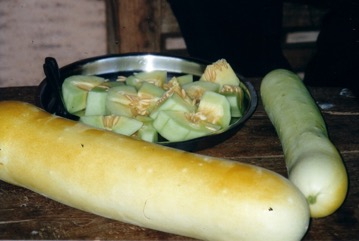
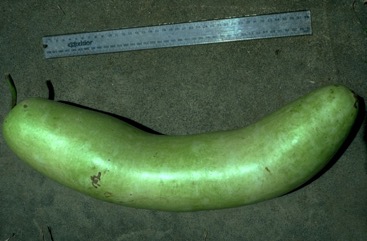
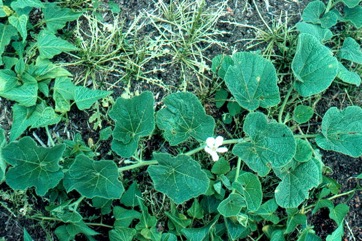
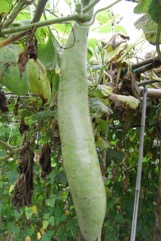
References
Abbiw, D.K., 1990, Useful Plants of Ghana. West African uses of wild and cultivated plants. Intermediate Technology Publications and the Royal Botanic Gardens, Kew. p 39
Achigan-Dako, E, et al (Eds), 2009, Catalogue of Traditional Vegetables in Benin. International Foundation for Science.
Altschul, S.V.R., 1973, Drugs and Foods from Little-known Plants. Notes in Harvard University Herbaria. Harvard Univ. Press. Massachusetts. no. 4373 (As Lagenaria leucantha)
Ambasta, S.P. (Ed.), 2000, The Useful Plants of India. CSIR India. p 313
Anderson, E. F., 1993, Plants and people of the Golden Triangle. Dioscorides Press. p 214
Ara, R. I. T., 2015, Leafy Vegetables in Bangladesh. Photon eBooks. p 59
Beckstrom-Sternberg, Stephen M., and James A. Duke. "The Foodplant Database." http://probe.nalusda.gov:8300/cgi-bin/browse/foodplantdb.(ACEDB version 4.0 - data version July 1994)
Bianchini, F., Corbetta, F., and Pistoia, M., 1975, Fruits of the Earth. Cassell. p 108
Bodkin, F., 1991, Encyclopedia Botanica. Cornstalk publishing, p 614
Boedecker, J., et al, 2014, Dietary contribution of Wild Edible Plants to women’s diets in the buffer zone around the Lama forest, Benin – an underutilized potential. Food Sec. 6:833–849
Burkill, H. M., 1985, The useful plants of west tropical Africa, Vol. 1. Kew.
Burkill, I.H., 1966, A Dictionary of the Economic Products of the Malay Peninsula. Ministry of Agriculture and Cooperatives, Kuala Lumpur, Malaysia. Vol 2 (I-Z) p 1316 (As Lagenaria leucantha)
Chin, H.F., & Yong, H.S., 1996, Malaysian Fruits in Colour. Tropical press, Kuala Lumpur p 74
Cundall, P., (ed.), 2004, Gardening Australia: flora: the gardener's bible. ABC Books. p 792
Dansi, A., et al, 2008, Traditional leafy vegetables and their use in the Benin Republic. Genet Resour Crop Evol (2008) 55:1239–1256
Dey, A. & Mukhererjee, A., 2015, Living and Survival Amidst Hunger: Wild Edible Botanicals as a Prime Forest Productivity in the Rural Purulia District, West Bengal, India from Colonial to Present. Research Journal of Forestry 9(3): 71-86 (As Lagenaria vulgaris)
Dhyani, S.K., & Sharma, R.V., 1987, Exploration of Socio-economic plant resources of Vyasi Valley in Tehri Garwhal. J. Econ. Tax. Bot. Vol. 9 No. 2 pp 299-310
Esquinas-Alcazar, et al, 1983, Genetic Resources of Cucurbitaceae. International Board of Plant Genetic Resources.
Facciola, S., 1998, Cornucopia 2: a Source Book of Edible Plants. Kampong Publications, p 87
FAO, 1988, Traditional Food Plants, FAO Food and Nutrition Paper 42. FAO Rome p 343
Farooq, S., et al, 2012, Ethnobotanical Studies of the Flora of Tehsil Birmal in South Waziristan Agency, Pakistan. Pak. J. Weed Sci. Res. 18(3): 277-291
Flora of Australia, Volume 8, Lecythidales to Batales, Australian Government Publishing Service, Canberra (1982) p 172
Flora of Pakistan. www.eFloras.org
Foo, J.T.S.(ed), 1996, A Guide to Common Vegetables. Singapore Science Foundation. p 58
Fowler, D. G., 2007, Zambian Plants: Their Vernacular Names and Uses. Kew. p 22
French, B.R., 1986, Food Plants of Papua New Guinea, A Compendium. Asia Pacific Science Foundation p
French, B.R., 2010, Food Plants of Solomon Islands. A Compendium. Food Plants International Inc. p 138
Gangte, H. E., et al, 2013, Wild Edible Plants used by the Zou Tribe in Manipur, India. International Journal of Scientific and Research Publications, Volume 3, Issue 5 (As Lagenaria vulgaris)
Goode, P., 1989, Edible Plants of Uganda. FAO p 26
Grubben, G. J. H. and Denton, O. A. (eds), 2004, Plant Resources of Tropical Africa 2. Vegetables. PROTA, Wageningen, Netherlands. p 349
Guil-Guerrero, J. L., et al, 2001, Edible Wild Plants. in Recent Progress in Medicinal Plants Vol. 8 Sci. Tech publishing, Texas (As Lagenaria vulgaris)
Guite, C., 2016, A study of wild edible plants associated with the Paite tribe of Manipur, India, International Journal of Current Research. Vol. 8, Issue, 11, pp. 40927-40932 (As Lagenaria vulgaris)
Harris, F. M. A. and Mohammed, S., 2003, Relying on Nature: Wild Foods in Northern Nigeria. Ambio Vol. 32 No. 1. p 25-30
Henty, E.E., 1980, Harmful Plants in Papua New Guinea. Botany Bulletin No 12. Division Botany, Lae, Papua New Guinea. p 44
Hide, R., et al, 1979, A checklist of some plants in the territory of the Sinasina Nimai (Simbai Province, Papua New Guinea), with notes on their uses. Department Anthropology, University of Aukland
Hu, Shiu-ying, 2005, Food Plants of China. The Chinese University Press. p 704
INFOODS:FAO/INFOODS Databases
Jardin, C., 1970, List of Foods Used In Africa, FAO Nutrition Information Document Series No 2.p 44, 85
Kays, S. J., and Dias, J. C. S., 1995, Common Names of Commercially Cultivated Vegetables of the World in 15 languages. Economic Botany, Vol. 49, No. 2, pp. 115-152
Kiple, K.F. & Ornelas, K.C., (eds), 2000, The Cambridge World History of Food. CUP p 1736
Kumar, A., et al, 2012, Ethnobotanical Edible Plant Biodiversity of Lepcha Tribes. Indian Forester, 138 (9):798-803 (As Lagenaria esculentum)
Kuo, W. H. J., (Ed.) Taiwan's Ethnobotanical Database (1900-2000), http://tk.agron.ntu.edu.tw/ethnobot/DB1.htm
Latham, P., 2004, Useful Plants of Bas-Congo province. Salvation Army & DFID p 160
Larkcom, J., 1991, Oriental Vegetables, John Murray, London, p 85
Lazarides, M. & Hince, B., 1993, Handbook of Economic Plants of Australia, CSIRO. p 143
Lembogi Biologi Nasional, 1980, Sayur-sayuran. Balai Pustaka, Jakarta. p 76
Liengola, I. B., 2001, A contribution to the study of native edible plants by the Turumbu and Lokele of the Tshopo District, Province Orientale, D. R. Congo. Syst. Geogr. Pl. 71:687-698
Liu, Yi-tao, & Long, Chun-Lin, 2002, Studies on Edible Flowers Consumed by Ethnic Groups in Yunnan. Acta Botanica Yunnanica. 24(1):41-56
Long, C., 2005, Swaziland's Flora - siSwati names and Uses http://www.sntc.org.sz/flora/
Lulekal, E., et al, 2011, Wild edible plants in Ethiopia: a review on their potential to combat food insecurity. Afrika Focus - Vol. 24, No 2. pp 71-121
Macmillan, H.F. (Revised Barlow, H.S., et al) 1991, Tropical Planting and Gardening. Sixth edition. Malayan Nature Society. Kuala Lumpur. p 334
Manandhar, N.P., 2002, Plants and People of Nepal. Timber Press. Portland, Oregon. p 283
Martin, F.W. & Ruberte, R.M., 1979, Edible Leaves of the Tropics. Antillian College Press, Mayaguez, Puerto Rico. p 190 (As Lagenaria leucantha)
Martin, M.A., 1971, Introduction L'Ethnobotanique du Cambodge. Centre National de la Recherche Scientifique. Paris.
Maundu, P. et al, 1999, Traditional Food Plants of Kenya. National Museum of Kenya. 288p
Medhi, P. & Borthakur, S. K., 2012, Phytoresources from North Cachur Hills of Assam -3: Edible plants sold at Hflong market. Indian Journal or Natural Products and Resources. 3(1) pp 84-109
Menninger, E.A., 1977, Edible Nuts of the World. Horticultural Books. Florida p 108
Miguel, E., et al, 1989, A checklist of the cultivated plants of Cuba. Kulturpflanze 37. 1989, 211-357
Moerman, D. F., 2010, Native American Ethnobotany. Timber Press. p 292
Molla, A., Ethiopian Plant Names. http://www.ethiopic.com/aplants.htm
Morimoto, Y. & Mvere, B., 2004. Lagenaria siceraria (Molina) Standl. [Internet] Record from Protabase. Grubben, G.J.H. & Denton, O.A. (Editors). PROTA (Plant Resources of Tropical Africa), Wageningen, Netherlands. < http://database.prota.org/search.htm>. Accessed 16 October 2009.
Murtem, G. & Chaudhrey, P., 2016, An ethnobotanical note on wild edible plants of Upper Eastern Himalaya, India. Brazilian Journal of Biological Sciences, 2016, v. 3, no. 5, p. 63-81
Musinguzi, E., et al, 2006, Utilization of Indigenous Food Plants in Uganda: A Case Study of South-Western Uganda. AJFAND Vol. 6(2):
Mutie, F. G., 2020, Conservation of Wild Food Plants and Their Potential for Combatting Food Insecurity in Kenya as Exemplified by the Drylands of Kitui County. Plants 2020, 9, 1017
Norrington, L., & Campbell, C., 2001, Tropical Food Gardens. Bloomings Books. p 46 (Also as Lagenaria leucantha)
Nyadanu, D., et al, 2015, Agro-biodiversity and challenges of on-farm conservation: the case of plant genetic resources of neglected and underutilized crop species in Ghana. Genet. Resourc. Crop Evol. 62(7):
Ocho, D. L., et al, 2012, Assessing the levels of food shortage using the traffic light metaphor by analyzing the gathering and consumption of wild food plants, crop parts and crop residues in Konso, Ethiopia. Journal of Ethnobiology and Ethnomedicine 8:30
Ochse, J.J. et al, 1931, Vegetables of the Dutch East Indies. Asher reprint. p 190 (As Lagenaria leucantha)
Okigbo, B.N., Vegetables in Tropical Africa, in Opena, R.T. & Kyomo, M.L., 1990, Vegetable Research and development in SADCC countries. Asian Vegetable Research and development Centre. Taiwan. p 38
Omawale, 1973, Guyana's edible plants. Guyana University, Georgetown p 108
Peekel, P.G., 1984, (Translation E.E.Henty), Flora of the Bismarck Archipelago for Naturalists, Division of Botany, Lae, PNG. p 549, 548
Peters, C. R., O'Brien, E. M., and Drummond, R.B., 1992, Edible Wild plants of Sub-saharan Africa. Kew. p 101
Pham-Hoang Ho, 1999, An Illustrated Flora of Vietnam. Nha Xuat Ban Tre. p 572
Phon, P., 2000, Plants used in Cambodia. © Pauline Dy Phon, Phnom Penh, Cambodia. p 393
Plants for a Future database, The Field, Penpol, Lostwithiel, Cornwall, PL22 0NG, UK. http://www.scs.leeds.ac.uk/pfaf/
Plants of Haiti Smithsonian Institute http://botany.si.edu/antilles/West Indies
Powell, J.M., Ethnobotany. In Paijmans, K., 1976, New Guinea Vegetation. Australian National University Press. p 110
Publ. Field Columbian Mus., Bot. Ser. 3:435. 1930
Purseglove, J.W., 1968, Tropical Crops Dicotyledons, Longmans. p 124
Rajapaksha, U., 1998, Traditional Food Plants in Sri Lanka. HARTI, Sri Lanka. p 154
Rashid, H. E., 1977, Geography of Bangladesh. Westview. p 263 (As Lagenaria vulgaris)
Royal Botanic Gardens, Kew (1999). Survey of Economic Plants for Arid and Semi-Arid Lands (SEPASAL) database. Published on the Internet; http://www.rbgkew.org.uk/ceb/sepasal/internet [Accessed 16th April 2011]
Rubaihayo, E. B., Conservation and use of traditional vegetables in Uganda. Bioversity International.
Ruiters-Welcome, A. K., 2019, Food plants of southern Africa. Ph.D. thesis. Univ. of Johannesburg p 50
Schneider, E., 2001, Vegetables from Amaranth to Zucchini: The essential reference. HarperCollins. p 107
Segnon, A. C. & Achigan-Dako, E. G., 2014, Comparative analysis of diversity and utilization of edible plants in arid and semi-arid areas in Benin. Journal of Ethnobiology and Ethnomedicine 2014, 10:80
Shah, S. K., 2014, Dietary contribution of underutilized minor crops and indigenous plants collected from uncultivated lands and forests in Nepal. in Promotion of Underutilized Indigenous Food Resources for Food Security and Nutrition in Asia and Pacific. FAO. Bangkok p 64 (As Lagenaria vulgaris)
Sharma, B.B., 2005, Growing fruits and vegetables. Publications Division. Ministry of Information and broadcasting. India. p 169
Shava, S., 2000, The Use of Indigenous Plants as Food by a Rural Community in the Eastern Cape: an Educational Exploration. Masters Thesis Rhodes University. p 65
Shava, S., et al, 2009, Traditional food crops as a source of community resilience in Zimbabwe. International Journal of the African Renaissance 4(1)
Siemonsma, J. S. and Piluek, K. (Eds), 1994, Plant Resources of South-East Asia No. 8 Vegetables. Prosea Foundation, Bogor, Indonesia, p 190
Sillitoe, P. 1995, An Ethnobotanical Account of the Plant Resources of the Wola Region, Southern Highlands Province, Papua New Guinea. J. Ethnobiol. 15(2): 201-235
Sina, B. & Degu, H. D., 2015, Knowledge and use of Wild Edible Plants in the Hula District of the Sidama Zone. International Journal of Bio-resource and Stress Management 6(3):352-365
Small, E., 2009, Top 100 Food Plants. The world's most important culinary crops. NRC Research Press. p 127
Solomon, C., 2001, Encyclopedia of Asian Food. New Holland. p 175
Song, M., et al, 2013, Traditional knowledge of wild edible plants in Jeju Island, Korea. Indian Journal of Traditional Knowledge. 12(2) pp 177-194
Staples, G.W. and Herbst, D.R., 2005, A tropical Garden Flora. Bishop Museum Press, Honolulu, Hawaii. p 267 (Drawing)
Sukenti, K., et al, 2016, Ethnobotanical study on local cuisine of the Sasak tribe in Lombok Island, Indonesia. Journal of Ethnic Foods. 3 (2016) 189-200 p 198
Swaziland's Flora Database http://www.sntc.org.sz/flora
Teron, R. & Borthakur, S. K., 2016, Edible Medicines: An Exploration of Medicinal Plants in Dietary Practices of Karbi Tribal Population of Assam, Northeast India. In Mondal, N. & Sen, J.(Ed.) Nutrition and Health among tribal populations of India. p 150
Thaman, R. R, 2016, The flora of Tuvalu. Atoll Research Bulletin No. 611. Smithsonian Institute p 81
Tindall, H.D., & Williams, J.T., 1977, Tropical Vegetables and their Genetic Resources, International Board for Plant Genetic Resources, Rome, p 50
Tindall, H.D., 1983, Vegetables in the tropics. Macmillan p. 171
Tronickova, E. & Krejcova, Z., 1987, Ortaggi, Instituto Geografico de Agostini, Cecoslovacchia. p 152
USDA, ARS, National Genetic Resources Program. Germplasm Resources Information Network - (GRIN). [Online Database] National Germplasm Resources Laboratory, Beltsville, Maryland. Available: www.ars-grin.gov/cgi-bin/npgs/html/econ.pl (10 April 2000)
Valder, P., 1999, The Garden Plants of China. Florilegium. p 195
Van Sam, H. et al, 2008, Uses and Conservation of Plant Species in a National Park. A case study of Ben En, Vietnam. Economic Botany 62:574-593
van Wyk, B., 2005, Food Plants of the World. An illustrated guide. Timber press. p 223
van Wyk, Be., & Gericke, N., 2007, People's plants. A Guide to Useful Plants of Southern Africa. Briza. p 46
van Wyk, B-E., 2011, The potential of South African plants in the development of new food and beverage products. South African Journal of Botany 77 (2011) 857–868
Vickery, M.L. and Vickery, B., 1979, Plant Products of Tropical Africa, Macmillan. p 100
Walter, A. & Lebot, V., 2007, Gardens of Oceania. ACIAR Monograph No. 122. p 204
Walters, T. W., 1989, Historical Overview on Domesticated Plants in China with Special Emphasis on the Cucurbitaceae. Economic Botany 43(3): 297-313
Wehmeyer, A. S, 1986, Edible Wild Plants of Southern Africa. Data on the Nutrient Contents of over 300 species
Whitaker,T.W., & Bemis,W.P., 1979, Cucurbits, in Simmonds N.W.,(ed), Crop Plant Evolution. Longmans. London. p 64
Williamson, J., 2005, Useful Plants of Malawi. 3rd. Edition. Mdadzi Book Trust. p 148
Wiriadinata, H., 1995, Ethnobotany of Economic Plants in the Baliem Valley, Jayawijaya, Irian Jaya, Indonesian Institute of Science, Bogor, Indonesia
Woodward, P., 2000, Asian Herbs and Vegetables. Hyland House. p 86
World Checklist of Useful Plant Species 2020. Royal Botanic Gardens, Kew
Yang, Si-Lin and Walters, T. W., 1992, Ethnobotany and the Economic role of the Cucurbitaceae of China. Economic Botany, Vol. 46, No. 4, pp. 349-367
Yeshi, K. et al, 2017, Taxonomical Identification of Himalayan Edible Medicinal Plants in Bhutan and the Phenolic Contents and Antioxidant Activity of Selected Plants. TBAP 7 (2) 2017 pp 89 - 106